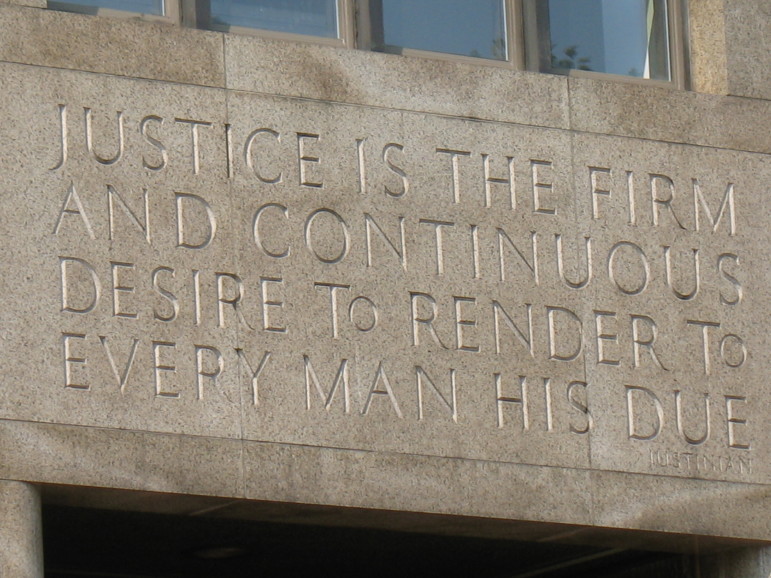It was December 8, 1993, still three weeks before Inauguration Day, when newly elected Mayor Rudolph Giuliani found himself in Bill Clinton’s office, annoyed at having to use precious minutes of face time with the President trying to correct a gaffe committed by the New York City Housing Authority.
According to an embarrassing New York Post story the day before, NYCHA officials under former Mayor David Dinkins misread a grant application and applied for only $500,000 of some $50 million the city was eligible to receive under a new federal public housing improvement program called “HOPE VI.” The mayor asked for a second crack, and Clinton, willing to do the mayor a favor, agreed. Giuliani later announced the city would get nearly $48 million from the Department of Housing and Urban Development for fixing up its most troubled projects.
“New York City,” Giuliani’s press secretary acidly told the Post, “now has a government that knows how to apply for grants.” Yet three years later, the mayor is preparing for his re-election campaign and New York has not seen a dime.
To get HOPE VI, the mayor’s housing officials eventually had to commit to destroying a number of public housing apartments, in keeping with the nationwide trend of tearing down troubled projects in order to save their tenants.
Unknowingly, Giuliani had fallen into the hidden trap of l990s federalism. In housing, the dictum of returning power to local governments seems to apply only if the locals are as conservative as Washington. If New York wants the money, it will have to follow the rules laid down for the HOPE VI program by Clinton housing strategists and the Congress. As it turns out, that means destroying at least 100 desperately needed public housing units in a Rockaways development.
“This is penalizing New York,” concedes NYCHA Deputy General Manager John Martinez, who says the Giuliani administration has let Washington know it is not happy with the requirement. New York City has a relatively well maintained public housing stock, a low-income housing shortage of near-catastrophic proportions, and little need for the kind of demolition work that has become common in the notorious projects of other cities including Chicago, Atlanta and Baltimore.
And even just talking about gutting a few units of public housing is emotional dynamite to NYCHA tenants. Residents of the Rockaways’ Beach 41st Street Houses, where NYCHA was initially going to spend the HOPE VI money, were so distrustful of the bureaucrats that they effectively stalled the project until HUD backed out in disgust.
Now, NYCHA’s planners have moved their blueprints 10 blocks down Beach Channel Drive to the Edgemere and Arverne Houses. These complexes are slated to receive the $47 million as well as another $22 million in HOPE VI funds that HUD awarded NYCHA in a subsequent application. But tenants at Edgemere have already begun to look askance at the windfall, even though HUD is considering the suspension of demolition mandates in future years.
“We know we’re not going to get the money if we say there’s no demolition,” tenant Yvonne Rodriguez told her neighbors at a tense tenant strategy meeting in mid-December. “The question is, are we willing to go for that?”
They will have to, Martinez tells City Limits. “Tenant input is invaluable,” he says. “But we will finalize this plan. We will move forward.”
_______
Funding from HOPE VI was to have been a beachhead for new development on the far end of the Rockaways Peninsula, which juts into the Atlantic from the eastern-most reaches of Queens. This community has always been isolated from the rest of the city. Once a picturesque resort, its fortunes began to sink in the l950s when cottage owners looked further afield for their summer holi-day retreats. Over the next two decades, city builders used some of the area’s vast spaces, made vacant by bulldozers, to build new public housing.
In the 1980s and ’90s, the neighborhood became a destination for some of the city’s most impoverished families. Crime rates rose and the community’s reputation sank. Working class tenants fled, leaving apartments to be filled by even poorer families from the city’s homeless shelters. Eventually, the six complexes here became known as some of the most troubled in NYCHA’s stock.
On the surface, this appeared to be exactly the kind of “distressed” community that HOPE VI was intended for.
The program is the latest incarnation of Bush administration HUD Secretary Jack Kemp’s attempt to deal with the social and physical ills plaguing public housing. The first HOPE program was Kemp’s abortive idea of selling off housing projects to their tenants. The new version is the work of Clinton’s departing HUD Secretary Henry Cisneros. It is more like a Marshall Plan for particularly forlorn developments, razing bombed-out, abandoned buildings and saturating the ground with funding for new apartments–mostly low-density townhouses–as well as social services and commercial development.
HOPE VI is not a big program in terms of dollars. Since it began in 1993, it has received an average allocation of only $550 million a year in a HUD budget of about $20 billion. But it is a key Clinton administration policy for dealing with the deterioration, poor management, crime, poverty and abandonment that have come to symbolize the nation’s public housing. HUD hopes to “reknit” the most isolated housing complexes back into the communities that surround them, explains Milan Ozdinec, director of the Office of Urban Revitalization, which manages HOPE VI.
HOPE VI gives local players, including housing authority officials, tenants and community leaders a role in designing a revitalization plan using a mix of strategies. In some cities, participants have opted to set up programs to help the chronically poor get jobs. Others are arranging low-income tax credit financing to encourage private housing development in the surrounding area. Housing authorities are also seeking new ways to market their developments to the working poor and lower middle class.
But HOPE VI’s prime directive is razing and rebuild-ing. Eighty percent of all allocated funds must go to demolition, building and rehabilitation. In the first three years of the program, 40 cities, including Chicago, Atlanta, San Francisco and Houston, received funds to reconfigure a total of 28,000 units of housing nationwide. Some 21,000 of those apartments were slated for demolition, says Ozdinec. He emphasizes that more than a third of these are already vacant, and they will be replaced by 14,500 apartments in attractive new town homes–complete with landscaping, playgrounds and social amenities like schools, computer centers and health clinics.
Ultimately, this means a net loss of public housing, he concedes. But HUD is providing Section 8 rent subsidies to people who might be displaced so they can find housing on the private market, he adds. “The problem is, everyone is focusing on the first half of this program,” Ozdinec says. “It’s a necessary part of redevelopment. This is about transforming these developments for the next 40 years.”
_______
In the Rockaways, NYCHA’s planners concluded Beach 41st Street Houses had little of the physical deterioration and abandonment that marked so many other HOPE VI projects nationwide. Instead, the main problems were crime, chronic poverty and isolation from the job centers of Manhattan, more than an hour away by subway.
Beginning in late 1994 and throughout 1995, NYCHA’s planners, working with tenant leaders and other consultants, agreed on the skeleton of a plan to supply dozens of new community services as well as job training, new security systems, health care facilities and a senior citizens’ center. The money would also be poured into apartment repairs.
However, in keeping with the HOPE VI mandate, there had to be some reconfiguration of existing buildings. Tenants wanted to know how the city planned to make this happen–and how much of a voice they’d have. Slowly, discussions began to break down.
Martinez, in charge of shepherding the project, maintains the city planned no wholesale demolition of any buildings. Instead, in response to community board concerns about density, NYCHA decided to reconfigure a number of apartments on the ground floors to house fewer people. He says the plan would have displaced only 50 to 75 of the project’s 712 families, adding that NYCHA planned to find new homes for everyone who had to move.
While Martinez insists the residents’ council knew all these details, that didn’t prevent an uproar in the community. “For whatever reason,” he says, “nobody made a concerted effort to quiet the fears of the residents.”
Finally, last July, after an angry meeting with tenants, federal officials threatened to pull the money if they could not reach an agreement within 30 days. The talks were at a standstill. According to Martinez, NYCHA simply could not agree to tenant demands that they be given final veto power over all HOPE VI decisions.
It is easy to see why resident leaders were mistrustful. NYCHA’s own December 1995 revitalization plan summary–still being distributed by the agency’s press office to describe the project–notes that the upper floors of several wings at Beach 41St would be removed to “lower the height of the buildings so that the buildings will better relate to the surrounding area.”
This kind of heavy demolition work would likely require evacuation of entire towers during construction, and that greatly worried residents, says Francis Johnson, head of the tenants council. Moreover, she insists, there were a half dozen different demolition ideas being floated at the time; there was no way to know which one the city would ultimately choose. NYCHA never committed to any final demolition plan on paper, Johnson says. She adds that all the tenants wanted was for NYCHA to sit down and talk in good faith.
“We were doing exactly what the mayor talks about every day, people taking responsibility for their community,” says resident council Vice President Patricia Frye. “The city,” adds Johnson, “didn’t communicate directly with the residents and they didn’t finish their plan. They needed someone to blame.”
_______
Now, tenants at the Edgemere and Arverne houses are facing the same question: Do residents have any power to stop demolition if they want to?
It is an irony that New York City’s first act of demolition may occur here. Edgemere Houses, home to some 3,860 residents, is a sprawling low-rise campus abutted on one side by the ocean, on another by acres of vacant land and around the remaining perimeter by apartment and co-op buildings of equal size or taller.
It’s one thing to take down a 19-story tower in Cabrini Green on Chicago’s Near North Side, where many of the units have long been abandoned and the surrounding housing is in pricey warehouse lofts and historic town homes. But on a peninsula crowned with miles of tall buildings, Edgemere is hardly noticeable, let alone intimidating.
Moreover, NYCHA has taken pains to keep its public housing in good condition. Cheap rentals are precious in New York; the citywide vacancy rate for apartments renting for less than $500 was below two percent in 1993, the last year data was collected. The act of destroying even 100 units is ill-advised, Martinez admits.
But, he says, when his office asked HUD if the city could get Out of the demolition requirement, HUD refused. He says NYCHA is lobbying to get the requirement removed for future grants, planning to make HUD aware of “New York’s continuing objection to some of these irrational things.”
Now, Martinez says, the object of the game is to calm fears of demolition at Edgemere. Unfortunately, tenants already have reason not to believe his word.
Late last summer, shortly before he submitted NYCHA’s grant application for the $22 million HOPE VI grant, Martinez promised residents–in no uncertain terms–that there would be no demolition. But on September 10, the day the application was due, HUD notified NYCHA that the equivalent of at least one building had to come down. Martinez immediately faxed Washington a letter saying he would raze the top few floors off Edgemere’s four tallest buildings.
When word got back to the residents, many were sure that NYCHA and the resident council had sold them out. Council President Sandy Campbell says she even received several death threats in the ensuing weeks.
On December 18, Martinez and his staff went out to the Rockaways and apologized. They told a meeting of some 50 Edgemere and Arverne residents that there would be no “topping off,” as the practice of rooftop demolition is known. Instead, 100 units on the ground floors would be gutted and replaced with community space for things like a day care center and a food co-op.
For now, tenants at Edgemere are taking it all under advise-ment. They have enlisted help from three local Legal Aid attorneys and Donald Vernon, a volunteer lawyer who was intimately involved in the Beach 41st battle.
Martinez promises he is going to do his best to communicate with tenants to enlist their support and avoid another Beach 4 1st-style fiasco. But, he adds, tenants must understand that, in the end, they have no formal power. “There are no appeals,” he says. NYCHA and HUD will make all final decisions.
If that’s really true, wonders tenant leader Francis Johnson, why didn’t NYCHA simply move forward with HOPE VI at Beach 41st Street? “If you ask me,” she says, “We were just being punished for getting involved.”








